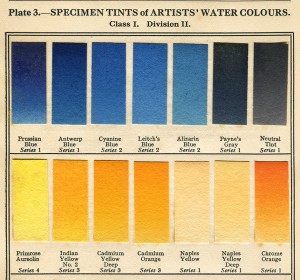Seeing the Light
 The Chapin Library has opened its winter exhibition, Seeing the Light: Color in Theory and Practice.
The Chapin Library has opened its winter exhibition, Seeing the Light: Color in Theory and Practice.
Seeing the Light was inspired by a presentation given last term by Chapin Librarian Wayne Hammond with faculty member Beverly Acha for her Studio Art course in painting. Ms. Acha wanted to introduce her students to ways color has been explained before they used it in their work. Our selection of books and prints sparked a good discussion. Many of these are in the present display, now expanded to include other examples of color in practice.
The exhibition begins with a nod to the ancients and their influential philosophies about color. Artists, meanwhile, were concerned with more practical matters, as they dealt with pigments: Leonardo da Vinci, for example, considered white the source of color and black its absence, and yellow, green, blue, and red as the colors with which a painter has to work. In addition, Leonardo observed that color was subjective as perceived by the eye, varying not only with light and shadow but also distance from an object. In the 17th century, scientists such as Robert Hooke maintained that white light is given color by passing through a glass lens or prism, but in 1666 Isaac Newton used a prism to refract a narrow beam of sunlight, producing an elongated spectrum, and a second prism to recombine the colors back into the original white, showing that color is not produced by modifying light, but is contained within it.
Newton’s Opticks is one of the cornerstone books of color theory, along with Johann Wolfgang von Goethe’s Theory of Colors and the Laws of Contrast of Color by Michel Eugène Chevreul. All three are in the Chapin Library and currently on display. With these in the exhibition are more contemporary resources such as T.M. Cleland’s classic Grammar of Color, a Horticultural Colour Chart, and a book on color instruction in public schools co-written by Louis Prang. Also on view are prints by Josef Albers from his Interaction of Color and Formulation, Articulation, which represent the most dramatic exploration of the art, science, and psychology of color in modern times.
To illustrate practical uses of color, Seeing the Light includes books ranging from a late 15th-century manuscript book of hours from the Attavanti workshop in Florence, to Jacob Bigelow’s American Medical Botany using color engravings, Walter Crane’s Baby’s Own Aesop printed from color woodblocks, an example of modern pochoir or stencil printing in colors, and Pauline Baynes’ Noah and the Ark to show the result of color printing by offset lithography compared with an original gouache painting for the book.
Seeing the Light: Color in Theory and Practice will be on display through March 25, 2016 in the Chapin Gallery (Sawyer Library Room 406). Hours are Monday through Friday, 10:00 a.m. to 5:00 p.m., and admission is free. – WGH
Shown is a detail from one of the tint specimens contained in a circa 1924 booklet describing oil and watercolor paints sold by Winsor & Newton.